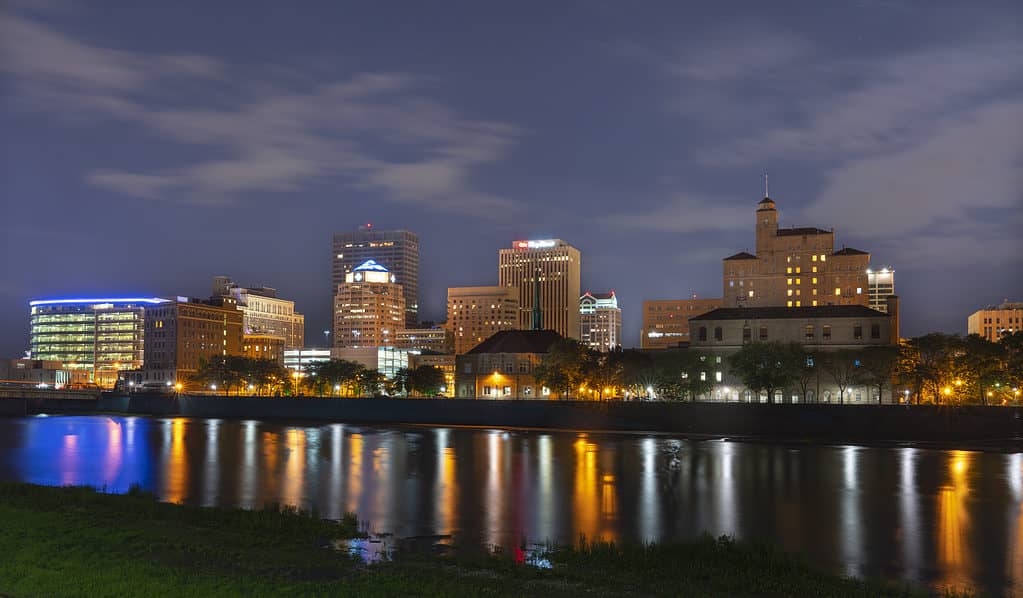Carrying the title of filthiest Ohio city is not the most desirable of labels, nor is it something most cities strive for. City life is all hustle and bustle. Unfortunately, that hustle and bustle comes with a price. Metropolitan areas throughout the United States are incredibly dense, population-wise—many people are squeezed into finite real estate.
Humanity rarely learns from past mistakes, and casual littering, though it may seem harmless to the individual, adds up quickly. This is especially true when many people are packed into a small area.
Cities try to combat this with the EPA and various neighborhood drives. However, when spending the day picking up 10 lbs of litter, other people are dumping 20 lbs on the ground. It’s a one-step forward, two-step back approach, and some cities become filthy in short order.
What Is The Filthiest Ohio City?
According to LawnStarter, a business-level lawn, maintenance, and semi-landscaping company, Dayton, Ohio, is the filthiest Ohio city and the 42nd filthiest city in the United States. Cincinnati is close behind in 2nd place and 50th nationwide.
Dayton isn’t just the filthiest city in the Buckeye State. It’s also one of the worst places to raise a family, according to WalletHub, and poorly ranked in school system quality, median income, violent crime, unemployment, housing, housing affordability, and divorce rate.
With all the city’s problems, it’s no wonder litter is the least of concerns.
Living Conditions

Dayton International Airshow, 2015.
©iStock.com/sreenath_k
Living conditions aren’t a singular thing—as in, there are roaches and mice infestations in your house or all the homes in the neighborhood. It’s a conglomeration of less-than-ideal circumstances. These sub-par circumstances create poor living conditions for everyone in that area.
The current population of Dayton, Ohio (metro) is 811,078. Since Dayton is 1,715 mi² in size, that boils down to 473 people per square mile, rounded up. That’s not the densest population ever, but it is a lot of people and more than enough to accumulate a lot of trash.
This is especially true with the rising homeless population in the city and too many people with a propensity toward tossing their trash on the ground. The unemployment rate in Dayton is 8.1%, with an average age of 39. Median home prices are well north of $200k, with the median monthly rent approaching $900/mo.
“Zombie homes” are also prevalent throughout Dayton, and their existence further embellishes the “filthiest Ohio city” label. By October 2019, Dayton had an estimated 5,000 zombie homes, with 1/5 of those considered nuisances. In other words, they more than qualify for a meeting with a front-end loader.
Pollution
In 2012, it wasn’t looking good for Dayton, Ohio, on the pollution front. Not only was it the filthiest Ohio city, even then, but it was also a particulate nightmare for fresh pairs of lungs everywhere close to or within the city.
Currently, the air pollution levels in Dayton are “good,” at least according to IQAir. The air pollution level is still above the WHO guideline values, though it’s clearly showing progress for the better. The City of Dayton Water OneSource, a Division of Environmental Management, keeps tabs on pollution levels throughout the city.
This includes dealing with water supply pollutants, stormwater management, emergency response programs, establishing and maintaining a sustainable practices policy, and planning or initiating neighborhood and riverside cleanup efforts.
Dayton Water OneSource also offers educational programs to inform Dayton residents about hazardous materials and provide residents with an environmental contact list. Water quality is another primary concern for obvious reasons, and Dayton Water OneSource conducts 200+ water tests daily.
They ensure the tap water in the city meets or exceeds EPA and state tap water guidelines.
Infrastructure

The Downtown Area of Dayton, Ohio, at night.
©iStock.com/Stephen Wood
The vast majority of present and future improvements to the infrastructure in Dayton are either on the docket or currently on the way. Starting in 2022, a sudden surge in the city’s desire to see infrastructure improvements took place. This ongoing effort directly responds to carrying the filthiest Ohio city label.
- Fiscal Year 2020: 55 wastewater projects begin, thanks to $5.1 billion in loans
- May 2022: New plans for eleven different public infrastructure projects
- July 2022: Active Transportation Plan begins, in coordination with the public
- July 2023: Sixth Ave. and Berry Street undergoing curb extensions, a connector, and repaving
- Also, in 2023, the Dayton Area Chamber of Commerce announced support for funding a study on expanding Amtrak commuter stops.
So, as you can see, the last three years feature a more excitable environmental and infrastructure focus for the city of Dayton. The latest economic and infrastructure update from the City of Dayton OneSource reveals the creation of over one thousand jobs, $300 million in economic output, and between $70 and $100 million invested in minority women’s business enterprises.
Consumer Satisfaction
This is not precisely a measure of satisfaction from Dayton residents concerning the purchase of products and real estate. It’s more a measure of needs, values, and challenges. The last time the City of Dayton took a measure of consumer satisfaction was in 2021. Today, Dayton is still the filthiest Ohio city, so you can imagine what it was two years ago.
There are a lot of different indicators in the consumer satisfaction survey. However, only some of them directly apply to the physical state of Dayton, Ohio.
- 57% consider Dayton, Ohio, to be an excellent place to live
- 54% express satisfaction with their neighborhoods
- 86% feel like they are safe in Dayton
- 65% don’t appreciate the condition of the streets
- 61% express satisfaction with waste collection, which is a 10% drop from previous surveys
- 28% witness drug activity on the roads, which is also down from previous surveys
- 52% don’t feel any stress or very little stress over their financial situations
Overall, 2021 seems to be an improvement over last years, and, considering the above list of infrastructure improvements, targets, and projections, 2023 (going into 2024) is probably somewhere along the upward curve.
Filthiest Ohio City And How It Affects The Local Wildlife

The Ohio EPA has conducted various surveys and studies over the years, and their most recent analysis is optimistic. Despite being the filthiest city in Ohio, the rivers that flow near the town are higher in quality than in previous measurements.
The EPA reports that the water in the Dayton area is some of the highest quality water in the state. That’s excellent news, as the local wildlife depends on fresh, clean water. Animals are just like humans, seeking shelter, food, and water; it looks like water is on the up and up in the Dayton area.
Of course, Dayton isn’t directly responsible for clean-flowing rivers, only insofar as where the river passes through the Dayton area. After all, the city can’t control what goes in the water upriver. Various animals depend on the rivers flowing through Ohio, including bobcats, fish, beavers, deer, coyotes, robins, thrushes, amphibians, and freshwater mussels.
The area around Dayton, Ohio, is full of wildlife, all of which also depend on high air quality. As mentioned above, the air quality in Dayton is improving, but it’s not where it needs to be just yet. On most days, “good” is the typical status, but it occasionally drops to “moderate.”
Raccoons, owls, opossums, foxes, squirrels, the red-bellied woodpecker, copperheads, the eastern fence lizard, and the red-shouldered hawk are a small sample of the wildlife living in and around the city. Dayton’s status as the filthiest Ohio city has a direct impact on their livelihood, just as it does on people.
Final Thoughts
Filthiest Ohio city or not, Dayton is working on it and, in general, is trending towards bettering the local environment, economy, and overall living conditions. With the level of projects currently underway and recent surveys indicating an improving quality of life among residents, Dayton may change its category sooner rather than later.
The photo featured at the top of this post is © Beeline Aerial/Shutterstock.com
Thank you for reading! Have some feedback for us? Contact the AZ Animals editorial team.







